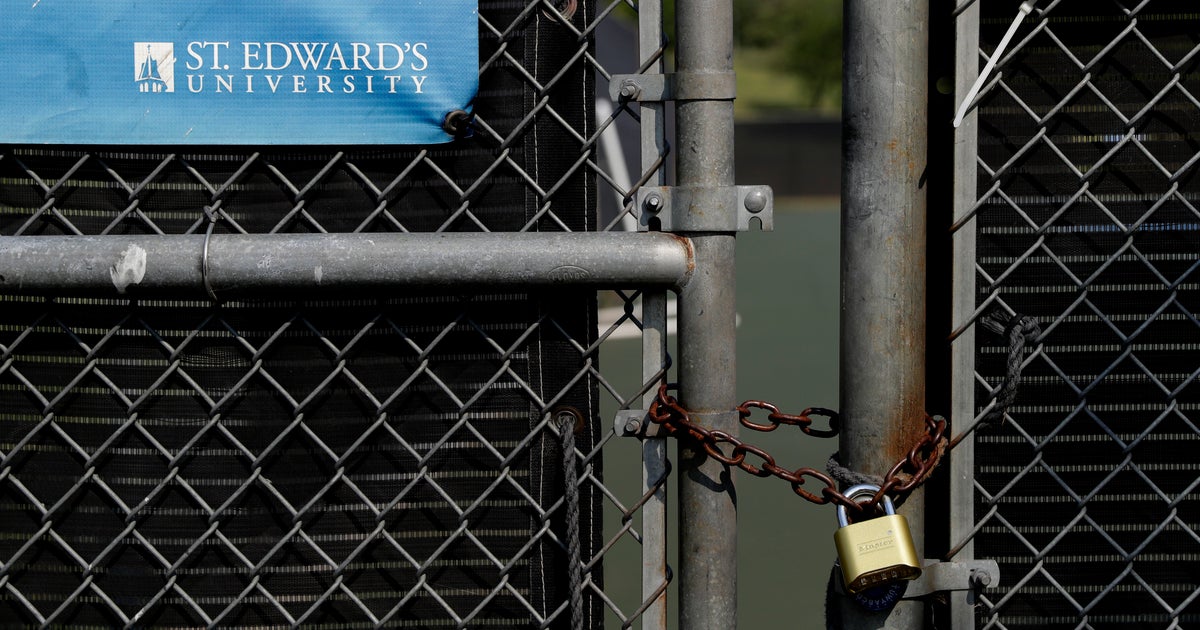Slashed St. Ed’s: Reeling school cuts teams, breaks hearts


Carlos Tercero had already been forced to move in with one of his teammates when St. Edward’s University closed its campus because of the pandemic, their seasons cut short like so many others across the nation.
Tercero and fellow golfer Nico Ciavaglia were adjusting to online classes off campus when things got even worse: The seniors-to-be have no team to return to next season.
The small school in Austin, Texas, slashed five teams from its successful Division II athletics programs: men’s and women’s golf, men’s and women’s tennis and men’s soccer, while also downgrading its cheer squad to a club sport.
They were easily among the most drastic sports cuts among NCAA schools so far as higher education administrators across the nation face a devastating financial blow from the pandemic. St. Edward’s is among five Division II schools known to have shut down athletic programs or drop individual programs since March 1, according to Associated Press research.
Urbana University in Ohio, which had a 19-sport DII program, announced last month that the school would close by summer. Notre Dame De Namur in California has eliminated its 12-sport program. Sonoma State (California) dropped women’s water polo, along with men’s and women’s tennis; and Fayetteville State in Arkansas dropped women’s tennis.
Only five total teams have been eliminated in cuts by four Division I schools, though the pace could pick up. And all of the decisions are hitting athletes hard.
“To have that ripped away from us so abruptly was just heartbreaking,” Ciavaglia said.
Head coaches of the affected teams, who have been to NCAA tournaments and won conference titles, say they were blindsided with the news during a Zoom meeting with St. Edward’s administrators on April 15 that lasted only a few minutes.
“They chopped our heads before we knew we were being accused of a crime,” said Estevam Strecker, the men’s tennis coach who had four All-Americans on his sixth-ranked team this spring.
An online petition started by Ciavaglia and Tercero to save the programs has received thousands of signatures. The school, which does not have a football team, has about 4,300 students.
After a series of meetings, administrators offered a daunting, long-shot chance: Each program would have to raise enough money by the end of May to cover five years of operational costs: $2.3 million for the golf teams, $2.2 million for men’s soccer, $2 million for the tennis teams and $800,000 for cheer. They would then have to raise another $50 million or so over the next five years to fully endow the teams; the school’s current overall endowment is about $110 million.
All of that wouldn’t even fund any scholarships for athletes on those teams; most of the more than 300 athletes receive some form of athletic, academic or need-based aid. The total cost of attendance for the 2020-21 school year for a student will be about $66,000.
Administrators declined comment, issuing a statement that said St. Edwards “will not compromise our student-athletes by running programs that are not properly funded” and noted it had outlined a financial pathway to reinstatement. Athletic director Debbie Taylor acknowledged to the Austin American-Statesman “it’s going to be very challenging” for the programs to raise that kind of money.
The St. Edward’s campus is about five miles from the University of Texas, which has one of the biggest and most expensive Division I athletic programs, annually generating well over $200 million in revenue. St. Edward’s operated its entire athletic program for about $9 million in 2018-19, according to federal records.
School President George Martin wrote in a letter to students that the school is bracing for major budget cuts, citing several million dollars in lost revenue after refunds to students for housing, meals and other fees. There is a projected 12% decline in enrollment and revenue for the next school year.
For Strecker, life has become a balance of confidence and despair, though he intends to proceed in the same way he has always coached his players: to never quit trying.
“On top of that, I’m try to balance we’re in the middle of a pandemic,” he said. “There are 30 million people that lost their jobs … and here we are about to call people and ask for money to save a tennis program.”
Strecker said he has raised about $8,000 per year, easily covering any amount that he might have gone over budget. The tennis program is now being asked to raise $2 million in 30 days and another $16.2 million the next five years.
St. Edward’s is the only one of the 19 schools in the Lone Star Conference to cut any teams so far. The school will be down to the minimum 10 teams necessary for Division II status unless some, or all, of the programs are restored.
“There is some optimism, although I think me and my teammates are now resigned to the decision, given that the university doesn’t seem to value our program and hastily cut it along with the five others,” said George Murray, a senior-to-be soccer player who finished his semester online after going home to England.
Murray is among about 60 athletes from the five teams with eligibility remaining. St. Edward’s will honor any athletic scholarships for the duration of their undergraduate enrollment or grant immediate release to any who prefer to transfer.
Ciavaglia and Tercero both said they likely will remain at St. Edward’s to finish their degrees as quickly as possible. Tercero, who is from Mexico, would lose credits toward his business degree and some scholarship money if he transferred to keep playing. He said he would also have to get his visa changed.
“I’m trying to finish school,” Tercero said. “So the school has put us in a very hard situation of basically making us stay at the school.”





